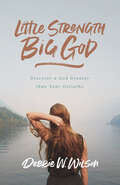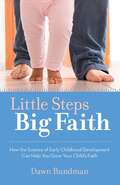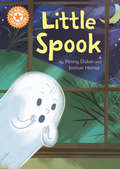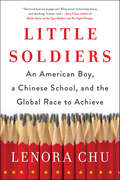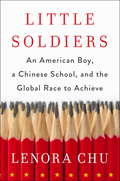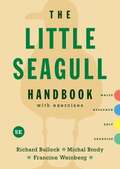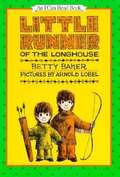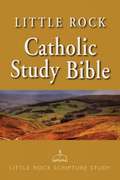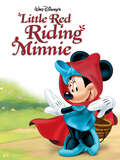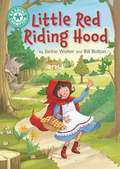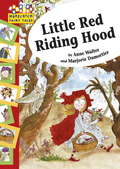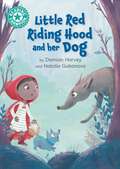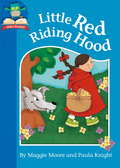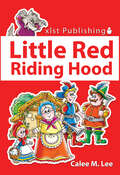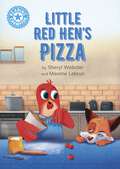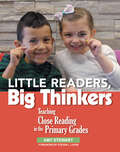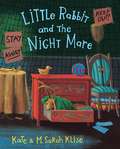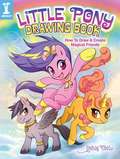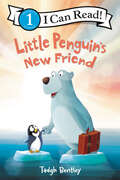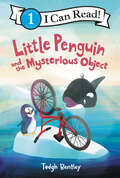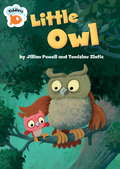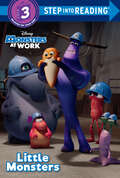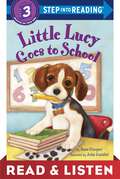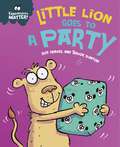- Table View
- List View
Little Strength, Big God: Discover a God Greater than Your Goliaths
by Debbie W. WilsonDiscover timeless truths to slay your giants. Like the faithful in Hebrews 11, you can become mighty in battle.Loss and intimidation are not new to God's people. What if you had to choose between--- Drowning your baby or letting your worst enemy raise him?- Bowing before an idol or being thrown into a fiery furnace?- Compromising your convictions or being tossed to the lions?- Living in fear or leading ill-equipped volunteers against an intimidating enemy?The believers who faced these decisions felt their limitations. Yet they found strength in the Lord. You can too. Using the men and women highlighted in the last half of Hebrews 11, Little Strength, Big God will help you turn your weaknesses into strengths to accomplish God's purpose in your life. When trouble attacks, you don't need a bigger God--you need clearer vision. Discover the transforming power of a God greater than your Goliaths and live strong now.
Little Steps, Big Faith: How The Science Of Early Childhood Development Can Help You Grow Your Child's Faith
by Dawn RundmanFrom brain science to language development and social skills, we've never known more about how children's minds develop in the first five years of life. Yet with all the information available, Christian parents may find themselves confused about how to apply these learnings to daily life with their children. In Little Steps, Big Faith, early childhood expert Dr. Dawn Rundman navigates the research to arrive at surprising insights about how very young children experience God, and how parents can use science to teach faith.
Little Spook: Independent Reading Orange 6 (Reading Champion #160)
by Penny DolanIn this story, Little Spook is afraid of something - but none of the Spook family can work out what is frightening him. Then a little firefly comes to the rescue ...Reading Champion offers independent reading books for children to practise and reinforce their developing reading skills.Fantastic, original stories are accompanied by engaging artwork and a reading activity. Each book has been carefully graded so that it can be matched to a child's reading ability, encouraging reading for pleasure.Independent Reading: Orange stories are perfect for children aged 5+ who are reading at book band 6 (Orange) in classroom reading lessons.
Little Soldiers: An American Boy, a Chinese School, and the Global Race to Achieve
by Lenora ChuNew York Times Book Review Editor’s Choice; Real Simple Best of the Month; Library Journal Editors’ PickIn the spirit of Battle Hymn of the Tiger Mother, Bringing up Bébé, and The Smartest Kids in the World, a hard-hitting exploration of China’s widely acclaimed yet insular education system that raises important questions for the future of American parenting and educationWhen students in Shanghai rose to the top of international rankings in 2009, Americans feared that they were being "out-educated" by the rising super power. An American journalist of Chinese descent raising a young family in Shanghai, Lenora Chu noticed how well-behaved Chinese children were compared to her boisterous toddler. How did the Chinese create their academic super-achievers? Would their little boy benefit from Chinese school? Chu and her husband decided to enroll three-year-old Rainer in China’s state-run public school system. The results were positive—her son quickly settled down, became fluent in Mandarin, and enjoyed his friends—but she also began to notice troubling new behaviors. Wondering what was happening behind closed classroom doors, she embarked on an exploratory journey, interviewing Chinese parents, teachers, and education professors, and following students at all stages of their education. What she discovered is a military-like education system driven by high-stakes testing, with teachers posting rankings in public, using bribes to reward students who comply, and shaming to isolate those who do not. At the same time, she uncovered a years-long desire by government to alleviate its students’ crushing academic burden and make education friendlier for all. The more she learns, the more she wonders: Are Chinese children—and her son—paying too high a price for their obedience and the promise of future academic prowess? Is there a way to appropriate the excellence of the system but dispense with the bad? What, if anything, could Westerners learn from China’s education journey? Chu’s eye-opening investigation challenges our assumptions and asks us to consider the true value and purpose of education.
Little Soldiers: An American Boy, a Chinese School and the Global Race to Achieve
by Lenora Chu'I couldn't put this book down. Whip smart, hilariously funny and shocking. A must-read'Amy Chua, Yale Law Professor and author of Battle Hymn of the Tiger MotherIn 2009, Lenora Chu, her husband Rob, and toddler Rainey, moved from LA to the Chinese megacity Shanghai. The US economy was spinning circles, while China seemed to be eating the planet's economic lunch. What's more, Shanghai teenagers were top in the world at maths, reading and science. China was not only muscling the rest of the world onto the sidelines, but it was also out-educating the West. So when Rainey was given the opportunity to enroll in Shanghai's most elite public kindergarten, Lenora and Rob grabbed it. Noticing her rambunctious son's rapid transformation - increasingly disciplined and obedient but more anxious and fearful - Lenora begins to question the system. What the teachers were accomplishing was indisputable, but what to make of their methods? Are Chinese children paying a price for their obedience and the promise of future academic prowess? How much discipline is too much? And is the Chinese education system really what the West should measure itself against? While Rainey was at school, Lenora embarked on a reporting mission to answer these questions in a larger context. Through a combination of the personal narratives and thoughts of teachers, parents, administrators and school children, Little Soldiers unpacks the story of education in China.
Little Seagull Handbook with Exercises
by Richard Bullock Francine Weinberg Michal BrodyWrite. Research. Edit. Everything students need in an affordable handbook they truly use. The Little Seagull Handbook is the #1 best-selling handbook because it’s easy to use, easy to afford, and covers everything students need―no more, no less. Intuitive organization, color coding, and jargon-free instruction for common kinds of writing make it a reference tool that student writers truly rely on. This edition includes new advice designed for developing writers, new advice for using inclusive language, and two new complete model student essays using MLA and APA documentation.
Little Runner of the Longhouse (I Can Read! #Level 2)
by Arnold Lobel Betty BakerThe time of the New Year was an exciting one. The longhouses of the Iroquois were filled with busy people as everyone helped prepare for the celebration. Little Runner envied the big boys who put on masks and threatened to steal prized possessions until they were dissuaded with large servings of maple sugar. It was an Iroquois ceremony, but it was the candy, not the custom, that appealed to Little Runner. Little Runner did his best to convince his mother that he was one of the big boys, but she could not be fooled. How he finally achieved his goal makes a warmly happy story. The stunning pictures and skillfully chosen words realistically re-create the Iroquois way of life, and children will find this book that they can actually read by themselves both absorbing and delightful.
Little Rock Catholic Study Bible
by Catherine Upchurch Irene Nowell Ronald D. Witherup Mary ElsberndOpen the Little Rock Catholic Study Bible and feel at home with the Word of God. Through accessibly written information and engaging visuals that highlight and clarify significant areas of Scripture, readers will easily gain an understanding of these ancient texts that can be carried into today's world. Using the authorized translation in the New American Bible Revised Edition, this lasting volume is ideal for both personal use and group Bible study. The valuable information in the Little Rock Catholic Study Bible is offered in small notes and inserts that accompany the Bible texts as well as in expanded essays, articles, and graphics. Key symbols help readers quickly identify the type of information they need, such as explanations, definitions, dates, character and author profiles, archaeological insights, personal prayer starters, and insights connecting Scripture and its use in today's church. Colorful maps, timelines, photographs, and charts further enhance the study experience. Longer articles are dedicated to explaining study Bible fundamentals, the Catholic Church's use of the Bible, and the people and places of the biblical world.
Little Red Riding Minnie
by DISNEY BOOK GROUPLittle Red Riding Minnie's grandmother is awfully sick, so she decides to bake a batch of her famous cookies to make her grandmother feel better! But as soon as Big Bad Pete learns that Little Red Riding Minnie is baking cookies, he thinks up a crafty plan to steal the cookies for himself! Don't miss this hilarious retelling of the classic tale of Little Red Riding Hood—with a Disney twist!
Little Red Riding Hood: Independent Reading Turquoise 7 (Reading Champion #516)
by Bill Bolton Jackie WalterLittle Red Riding Hood is off to visit her grandmother, but the forest is full of danger ...This story is part of Reading Champion, a series carefully linked to book bands to encourage independent reading skills, developed with Dr Sue Bodman and Glen Franklin of UCL Institute of Education (IOE)Reading Champion offers independent reading books for children to practise and reinforce their developing reading skills.Fantastic stories are accompanied by engaging artwork and a reading activity. Each book has been carefully graded so that it can be matched to a child's reading ability, encouraging reading for pleasure.
Little Red Riding Hood: Hopscotch Fairy Tales
by Anne Walter Marjorie DumortierLittle Red Riding hood is off to Granny's house with a basket of food, but the wolf gets to Granny's house first. When Little Red Riding Hood arrives, she soon realises her Granny doesn't look quite right...
Little Red Riding Hood and her Dog: Independent reading Turquoise 7 (Reading Champion #517)
by Damian HarveyThis story is part of Reading Champion, a series carefully linked to book bands to encourage independent reading skills, developed with Dr Sue Bodman and Glen Franklin of UCL Institute of Education (IOE) Fantastic, original stories are accompanied by engaging artwork and a reading activity. Each book has been carefully graded so that it can be matched to a child's reading ability, encouraging reading for pleasure. Perfect for 5-7 year olds.In this twist on the original fairy tale, Little Red Riding Hood has a dog called Little Blue, and Little Blue really does not like the Big Bad Wolf!
Little Red Riding Hood (Must Know Stories: Level 1)
by Maggie Moore"Oh grandmother, what big ears you have!"A beautifully illustrated retelling of this favourite traditional story. Join Little Red Riding Hood at her grandmother's house - how will they escape the big bad wolf?Must Know Stories includes favourite tales, celebrating the diversity of our literary heritage. Level 1 stories are told in under 500 words, for children to read independently.
Little Red Riding Hood (Hopscotch: Fairy Tales #11)
by Anne WalterLittle Red Riding hood is off to Granny's house with a basket of food, but the wolf gets to Granny's house first. When Little Red Riding Hood arrives, she soon realises her Granny doesn't look quite right...
Little Red Riding Hood (Discover Fairy Tales)
by Calee M. LeeStranger danger comes with big teeth in this cautionary fairy tale. The beloved story is a howling good time—the better to keep kids&’ attention! Make sure you don&’t stop and talk to strangers! The classic story of Little Red Riding Hood has been retold with simple, rhythmic sentences for beginning readers and wiggly toddlers. Discover Fairy Tales are familiar stories with cute illustrations, perfect for the touchscreen generation.
Little Red Hen's Pizza: Independent Reading Blue 4 (Reading Champion #598)
by Sheryl WebsterThis story is part of Reading Champion, a series carefully linked to book bands to encourage independent reading skills, developed with Dr Sue Bodman and Glen Franklin of UCL Institute of Education (IOE)In this funny retelling of the traditional tale, Little Red Hen is making pizza. Fox is far too busy to help her ... until the pizza is nearly ready to eat!Reading Champion offers independent reading books for children to practise and reinforce their developing reading skills.Fantastic, original stories are accompanied by engaging artwork and a reading activity. Each book has been carefully graded so that it can be matched to a child's reading ability, encouraging reading for pleasure.Perfect for 5-6 year olds or those reading book band blue 4.
Little Readers, Big Thinkers: Teaching Close Reading in the Primary Grades
by Amy StewartYoung learners are full of questions and wonderings, so much so that sometimes they need a guide for their curiosity. Author Amy Stewart brings her manageable approach to close reading in Little Readers, Big Thinkers: Teaching Close Reading in the Primary Grades . With Stewart guiding, you'll be able to harness the big thinking we know is inside their inquisitive minds.She showcases ways that close reading can teach even the youngest students new ways to enjoy texts, think about them critically, and share that thinking with peers and adults.With its description of the pillars of close reading, multiple lesson sequences for grades K-2, and real-life classroom scenarios, Little Readers, Big Thinkers offers a trove of insights: What close reading is (and is not )How to encourage students to read like detectives-Ways to weave close reading practices into your lessonsHow to cultivate real reading, organic thinking, and deep conversationWhich books invite amazing learning and thinking experiencesBy giving young minds a great foundation, close reading will become a stepping stone to a lifelong love of reading.
Little Rabbit and the Night Mare
by Kate KliseOne night, while Little Rabbit is sleeping, a very scary creature appears in his dream. Little Rabbit is so worried about the "night mare" that he can't eat or sleep--and he certainly can't work on his school report that's due at the end of the week. He makes signs. He builds traps. But nothing keeps that night mare away... until Little Rabbit dreams up a brave and brilliant solution. Kate and Sarah Klise have created a heart-meltingly sweet story that will empower kids everywhere to face their fears. * note creative spelling in the beginning is true to print.
Little Pony Drawing Book
by Lindsay CibosA fun-filled guide to drawing ponies and other magical friends!There's only one thing more adorable than a little pony, and that's a little pony cartoonified! No wonder they've become pop culture superstars, loved by all ages. This book puts you in the creative saddle by showing you--step by friendly step--how to dream up and draw your own, original cartoon cuties.Start off on the right hoof by building characters from basic shapes.Learn how simple proportion adjustments allow you to create whole stable of pony types. Discover secrets to mastering action and poses, so you can make your ponies walk, gallop and prance across the page.Draw ponies that shine, shimmer and show their style with unique mane and tail styles, coat colorings, brands, fashions, and accessories.Follow step-by-step instructions to create a variety of other friends--from fantastical unicorns to sweet deer, alpaca and sheep.Loaded with ideas for facial expressions, costumes and fabulous flourishes, the Little Pony Drawing Book leads you on the trail to fun, friends and creative adventure!
Little Penguin's New Friend (I Can Read Level 1)
by Tadgh BentleyThe first I Can Read! book featuring beloved picture book character Little Penguin, star of Little Penguin Gets the Hiccups—a laugh-out-loud romp!For new readers who are fans of Mo Willems’s Elephant and Piggie series and Adam Rubin’s Dragons Love Tacos.A polar bear is coming to visit! Little Penguin has never met a polar bear, but his friends have heard they are scary, with sharp teeth and terrifying roars—and that they tell very bad jokes. But Little Penguin knows you can’t believe everything you hear, right?Little Penguin’s New Friend is a Level One I Can Read book, which means it’s perfect for children learning to sound out words and sentences.
Little Penguin and the Mysterious Object (I Can Read Level 1)
by Tadgh BentleyLittle Penguin solves his first mystery in this hilarious new I Can Read! adventure by Little Penguin Gets the Hiccups author Tadgh Bentley. For new readers who are fans of Mo Willems’s Elephant and Piggie series and Adam Rubin’s Dragons Love Tacos. Little Penguin has found something. But he’s not sure what it could possibly be. Luckily, penguins are great detectives—and he and his friends are on the case! Will they be able to solve the mystery? Little Penguin and the Mysterious Object is a Level One I Can Read book, which means it’s perfect for children learning to sound out words and sentences.
Little Owl (Tiddlers #26)
by Jillian PowellLittle Owl is trying to learn to fly. Big Owl wants to help, but Little Owl won't stop looking down!The Tiddlers series features fun stories with a word count of fewer than 50 words for children who are just starting to read.A word list at the beginning of the story allows for a quick check of the reader's ability to read and understand words before reading, and a puzzle at the end of the story encourages rereading for pleasure.
Little Monsters (Step into Reading)
by Nicole Johnson; illustrated by RH DisneyA step 3 leveled reader based on the Disney+ series Monsters at Work–complete with a poster!Inspired by Disney and Pixar&’s hit film Monsters, Inc., the new Disney+ animated show Monsters at Work follows Tylor Tuskmon, an enthusiastic member of the Monsters, Inc. Facilities Team (MIFT) who dreams of following in the footsteps of his idols—Mike and Sulley—and making his way up to the Monsters, Inc. Laugh Floor as a Jokester. Girls and boys ages 5 to 7 will love this Step 3 Step into Reading leveled reader based on an episode of the show and featuring a poster. Step 3 readers feature engaging characters in easy-to-follow plots about popular topics. For children who are ready to read on their own.
Little Lucy Goes to School: Read & Listen Edition (Step into Reading)
by Ilene CooperWith over 1.6 million Lucy books sold, this beguiling beagle has captured the hearts of both beginning readers and early chapter book fans! Learn to read with Ilene Cooper&’s adorable beagle puppy, Lucy! What does Bobby do all day at school? Lucy wants to know! So when Bobby&’s mom takes her there, Lucy takes off! She finds the lunchroom. She finds the library. But can she find Bobby? Step 3 (Reading on Your Own) is for children who are ready to read independently. Step 3 titles have stories with easy-to-follow plots and engaging characters.This Read & Listen edition contains audio narration.
Little Lion Goes to a Party (Experiences Matter)
by Sue GravesLittle Lion Goes to a Party offers a gentle introduction to the experience of attending a social occasion for young children.This funny, charming story is the perfect way to introduce young children to the experience of going to a party. Also included are suggestions for activities and ideas to talk through together to help children reflect on their own experiences.Little Lion has been invited to Panda's party. He is a bit excited, but he is worried about it too. What if he doesn't know many people there? What if he doesn't know how to play the games? Luckily, his family are on hand to help him overcome his fears.The Experiences Matter series of picture books provide a gentle means of discussing experiences, boosting self-esteem and reinforcing good behaviour. Supports the Personal, Social and Emotional Development Area of Learning in the Early Years Foundation Stage, and is also suitable for use with children in KS1 and can be used to discuss values. Suitable for children under 5.
